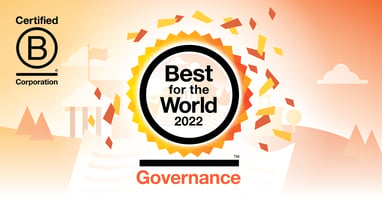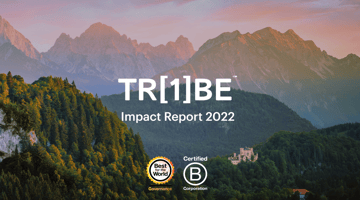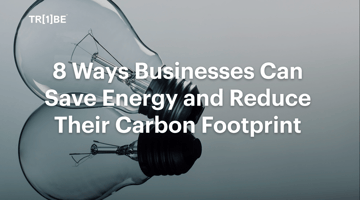One Tribe are delighted to announce we have been recognised as one of the top 100 B-Corps in B-Labs...
How (and why) Food and Drink Brands Should Reduce Emissions to Reach Net Zero

Food is one of our most essential resources that requires a huge amount of land and energy to grow, prepare, and deliver to our tables. Around 33% of global carbon emissions come from food systems, including agriculture and it’s now becoming critical for food and beverage companies to play a more prominent role in reducing emissions and reaching net zero.
In this article, we’ll explore how different sectors of the food industry — from agriculture, to manufacturing, to retailers, can transform their operations, reduce emissions and work with effective carbon offsetting solutions that will achieve net zero goals and help reverse the climate crisis.
What Are The Biggest Polluters That Contribute To The Extreme Carbon Footprint Of The Food And Drinks Industry?
Livestock
Animals bred for meat, dairy, eggs and seafood are one of the largest contributors to the emissions problem surrounding the food and beverage industry. Cattle, as an example, produce the greenhouse gas methane, adding excessive volumes of methane to the atmosphere.
Any on-farm activity, whether it be cattle management or manure management on land or fuel consumption from fishing vessels at sea, is a contributing factor to the increased spike in global emissions.
Crop Production
With an increase in animal husbandry comes an increase in crops to feed said animals. Food production emissions for human consumption already has a large footprint of its own and together with crop production for animal feed, the impact on the planet is a growing concern.
Serving no purpose other than to feed livestock bred for food production, the process of homing and maintaining livestock means emissions are created as a direct result of agricultural production. Variable emissions including the release of nitrous oxide from fertilisers and manure, methane from rice, and carbon dioxide from agricultural machinery are all factors contributing to a much larger, global problem. This is just for the crops needed to feed animals and does not even include the actual land they stand on.
Land Use And Deforestation
Land use and mass deforestation to make room for agriculture, water-intensive crops and livestock is perhaps one of the most problematic issues surrounding the food and drinks industry. Twice as many emissions result from land use for livestock than as for crops for human consumption.
Farms require space. And needing space for human crops, animal crops, and the animals themselves requires an ever growing amount of farmland. This type of agricultural expansion means more and more forests need to be cut down to make room for livestock and on-site farm operations. The result is an increase of carbon emissions and a destruction of our natural ecosystems.
Cutting down trees alone increases the amount of carbon released back into the atmosphere and also prevents these same trees from sequestering carbon dioxide from the atmosphere. This creates a huge imbalance where we are not only releasing vast amounts of emissions into the atmosphere but we are also removing A grade carbon sinks that have the power to offset those emissions. Effectively doubling the amount of harmful emissions released.
Supply Chains
Food processing, from converting produce from the farm to its final product, is just part of the supply chain process in food and drinks manufacturing. Product manufacturing, transport, packaging, and retail all require energy and resources to deliver the final product to a consumer.
Many assume that eating local food is the key to a low-carbon diet, however, transport emissions are often a very small percentage of food’s total emissions. That is, compared to the agriculture and land use elements. With supply chains consisting of so many processes, each with a carbon footprint of their own, it’s essential that we reduce emissions by evaluating and improving the sustainability of the supply chain process itself.
Reducing emissions from food production will be one of our greatest challenges in the coming decades. Unlike many aspects of energy production, where viable opportunities for upscaling low-carbon energy, renewable or nuclear energy, are available, the ways in which we can decarbonise agriculture are less clear. We need inputs such as fertilisers to meet growing food demands, and we can’t stop cattle from producing methane. We will need a menu of solutions: changes to diets; food waste reduction; improvements in agricultural efficiency; and technologies that make low-carbon food alternatives scalable and affordable.
Food Waste
Food waste emissions are extreme by comparison to that of the supply chain. One-quarter of emissions (3.3 billion tonnes of CO2eq) from food production ends up as food waste. Either from supply chain losses or consumers’ individual habits to throw away unused food and drink products. Durable packaging, refrigeration and food processing can all help to prevent food waste.
While these factors aren’t entirely avoidable, companies can improve processes to reduce emissions. Additionally, reducing emissions isn’t the only way food and beverage companies can reduce their footprints.foo

Offsetting Solutions For The Food And Beverage Industry
What’s unavoidable is that food needs to be planted, packaged and transported. This will always require energy and land. While that energy should be clean and renewable and that land should be sourced without deforestation, if those aren’t options for your company, then it’s time to consider offsetting solutions.
Even if you’re not sure of your company’s carbon footprint, calculating it shouldn’t be too hard. Not only are there companies dedicated to the practice and a reliable certification system for doing so, but the UK government also provides carbon calculation guides for businesses large and small.
Once you’re aware of your carbon footprint and have a strategic plan in place to reduce as many emissions as possible, you can then start considering carbon offsets. Carbon offsetting is the process of directly removing carbon from the atmosphere or contributing financially to those efforts. These efforts usually involve planting or protecting carbon-efficient trees that draw and sequester carbon from the atmosphere. However, the crucial factor to consider when buying offsets is not the method but the seller’s reliability.
One Tribe Global offers a carbon offset marketplace that enables the secure purchase of certified carbon credits from projects following environmental and ethical best practices. If you’re a manufacturer, farmer or other top-of-funnel producer of food and beverages, this may be your best option for reducing carbon emissions. In fact, One Tribe already has a list of food manufacturers and drinks brands successfully reducing emissions via offsets.
How Fast-Moving Consumer Goods (FMCG) And Retailers Can Reduce Their Carbon Emissions
However, if you’re conducting a high volume of transactions, there are other offset methods you can use to maximise your environmental benefit. For retailers or DTC food and drinks brands, you should consider building offsets into your purchase process. Rather than buying an upfront, fixed carbon offset, you can build it into your retail process using a partner (like One Tribe) with access to climate action tools.
How does it work? These tools allow you to set up your sales channels so that a small percentage of every transaction goes to financially supporting carbon offsets, which automatically scales your business,and therefore your emissions, to your total carbon offsets. Not only will this provide an economically efficient means of calculating and distributing your financial contribution but it unlocks marketing potential related to each purchase’s impact.

Consider One Tribe partner brand Karma Drinks, not only are they able to use the statistics on their Climate Action page in marketing campaigns, but they can show each individual buyer what the impact of their purchase is. This is useful for both a direct sales organisation and retail partners alike in their efforts to sell more sustainably.

The Non-Offset Angle: Creating And Selling More Sustainable Food And Drinks
Of course, the best method for reducing carbon emissions is not producing them in the first place. For food and beverage companies, there are a lot of ways to achieve this. A great way to achieve this is by creating and selling more sustainable food and beverages. How can this be achieved?
First, consider the ingredients you use in your product. Do you rely on meat or animal-based products when you don’t need to? Are you using carbon-intensive crops like rice when there are other options? Next, consider the supply chain of your products. Can you transform your own supply chain to be more efficient or work with a more sustainable partner for a comparable cost? The truth is that cost shouldn’t be the only factor in determining which raw materials go into your product and how it’s transported. As the climate crisis intensifies, the human and economic cost of carbon emissions must be factored in too.
However, even from the cost angle, the outlook is good. Not only are 77 percent of consumers convinced climate action must be taken (and especially by businesses), but up to 33% are willing to pay more for sustainable goods, according to Deloitte UK. So, there isn’t just a moral mandate to transform your food and drinks business, but an economic one as well.
Takeaway: Offsetting Solutions Are Great For A Carbon-Intensive Industry, But Don’t Ignore Reduction
Reaching net zero likely won’t take as long as you expect, but for businesses in the food and drinks space, it can be greatly sped up by purchasing carbon offsets. However, reductions in energy usage and a pivot toward sustainable products are the foundation of any environmental strategy.


